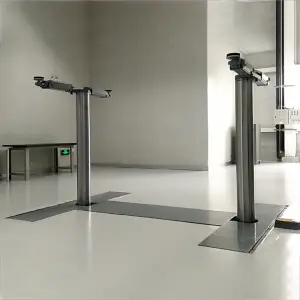****
The automotive industry is in the midst of a major transformation, as the push towards sustainability and reduced carbon emissions drives the development of new energy vehicles (NEVs). Central to this revolution is the advancement of new energy vehicle battery lift systems. These technologies not only enhance the efficiency of battery production and installation but also play a pivotal role in improving the safety and accessibility of electric vehicles (EVs). As the demand for NEVs continues to soar, innovations in battery lift systems have become increasingly essential.

Revolutionizing the Automotive Industry: The Importance and Impact of New Energy Vehicle Battery Lift Systems
One of the key challenges in the electric vehicle sector is the large, heavy batteries that power these vehicles. As EV manufacturers push the boundaries of battery capacity to extend range and improve performance, the weight of these components has increased significantly. This creates logistical challenges during the manufacturing process as well as issues related to vehicle servicing and repairs. New energy vehicle battery lift systems are designed to address these challenges, providing the necessary support for the efficient movement and handling of batteries throughout the production and maintenance lifecycle.

Revolutionizing the Automotive Industry: The Importance and Impact of New Energy Vehicle Battery Lift Systems
Battery lift systems are specialized equipment designed to safely lift and transport large, heavy batteries with precision. These systems utilize hydraulic or electric lifting mechanisms that reduce physical strain on workers while minimizing the risk of damage to the batteries themselves. As a result, they enhance safety conditions in both manufacturing plants and service centers where EV batteries are installed and replaced.
One of the primary advantages of advanced battery lift systems is the ability to streamline the production process. In factories where NEVs are assembled, time is of the essence. Battery lift systems enable manufacturers to quickly and safely position the battery pack within the vehicle chassis, reducing assembly time and increasing overall productivity. This, in turn, allows manufacturers to scale their production efforts and meet the growing demand for electric vehicles in a timely manner.
In addition to improving assembly efficiency, battery lift systems also offer substantial benefits in terms of maintenance. As electric vehicles become more mainstream, service centers face the challenge of quickly and safely accessing and replacing batteries. Utilizing a battery lift system allows technicians to handle heavy batteries without the need for extensive physical labor, expediting repair times and enhancing the overall service experience for customers. This efficiency is particularly important as EVs become more prevalent, and service centers aim to keep pace with the influx of electric vehicles.
Furthermore, safety is a critical factor that cannot be overlooked. The weight and potential hazards associated with handling lithium-ion batteries necessitate the implementation of specialized equipment like battery lifts. Accidents caused by improper handling can lead to serious injuries and costly damage. By utilizing a reliable battery lift system, automotive companies can adhere to strict safety regulations and mitigate risks while handling these essential components.
As the automotive industry continues to evolve, sustainability and eco-friendliness are becoming paramount. Innovations in battery technology are inherently tied to environmental initiatives aimed at reducing emissions. New energy vehicle battery lift systems not only support these advancements but also embody the principles of sustainability by reducing waste and improving efficiency in manufacturing processes.

Revolutionizing the Automotive Industry: The Importance and Impact of New Energy Vehicle Battery Lift Systems
Additionally, the rise of automation in manufacturing operations is yet another driving force behind the adoption of new energy vehicle battery lift systems. Robotics and automated systems are becoming increasingly integrated into production lines, and battery lifts can be easily incorporated into these technologies. This confluence of automation and battery lift systems can lead to enhanced productivity, lower labor costs, and fewer human errors.
In conclusion, new energy vehicle battery lift systems are essential components that support the growing demand for electric vehicles. By improving efficiency in production, enhancing safety in handling, and facilitating quicker maintenance, these systems play a pivotal role in the success of the NEV market. As the automotive industry moves toward a greener future, innovations in battery handling technology will undoubtedly continue to evolve, ensuring that manufacturers and service centers are well-equipped to meet the challenges and opportunities that lie ahead. The future of transportation is electric, and with it, the importance of advanced systems like battery lifts will only increase.Quick Lift




